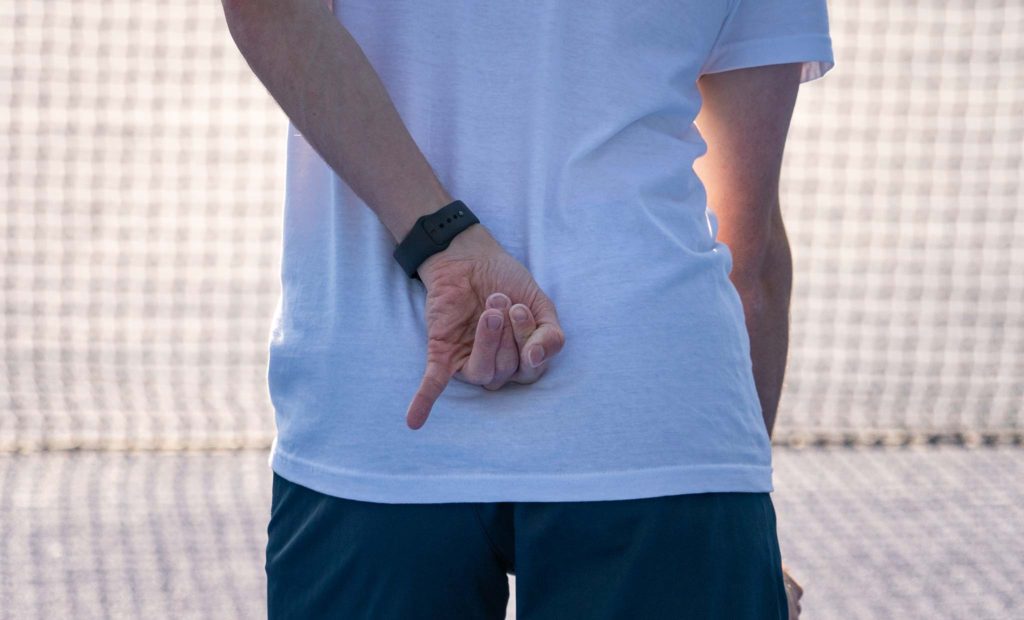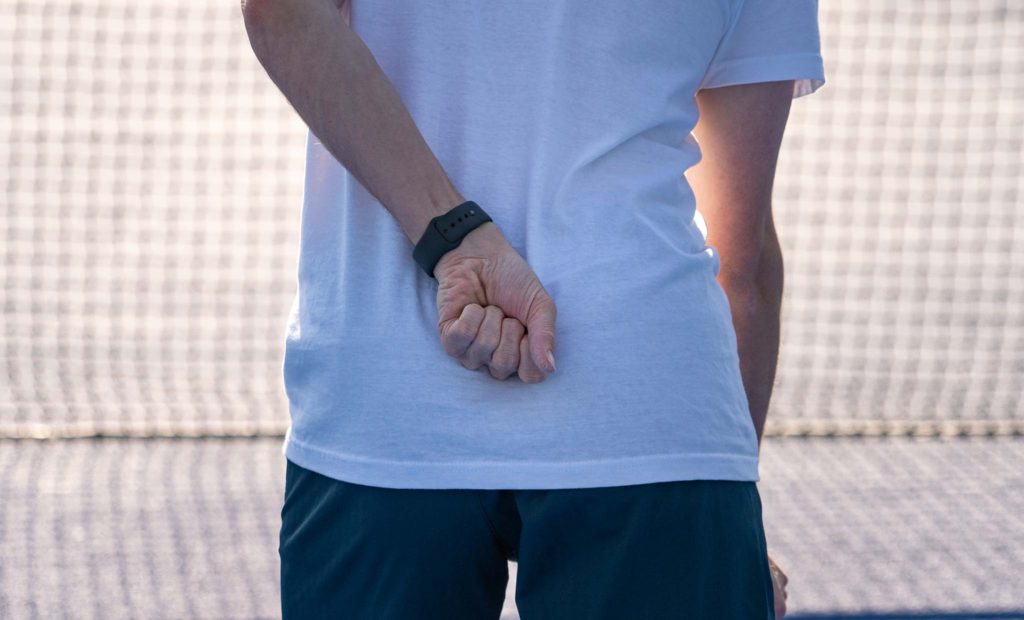In doubles, communication is key. Making sure you and your partner know exactly what’s going on is one of the most fundamental part of doubles tennis. Therefore communicating with your partner and telling them what you plan to do makes you much more likely to be successful on court.
You won’t always get the opportunity to speak to your partner during a game so instead you want to use hand signals. You may have seen professional players using these when watching matches on TV. Now if it’s the first time you’ve used these and you’re a recreational player you may find them to be rather confusing so we thought we’d put together a bit of a guide on how to use hand signals in doubles.
What Do Hand Signals Mean In Doubles Tennis?
In doubles tennis, players often use hand signals to communicate strategy when planning points. The hand signals are made by the net player and are used to indicate where the server will hit their serve to (directional signal) and where the net player will move to (movement signal).
There are five commonly used hand signals in doubles:
- Three directional signals (T-serve, Body serve and Wide serve)
- Two net-player movement signals (stay or poach).
Just keep in mind that hand signals can vary from one player to another. Most right-handed players will often use their left hand for signalling (as you’ll see me do in the photos below), while some may use their right hand. That might make hand signals look a little different, so it’s always worth checking what each signal means with your partner before you start the match.
Serve Direction Hand Signals
The first signal indicates where the player will serve: Out wide, to the body or middle, or down the T. You’ll generally use three different signals, pointing to the area of the court the serve should go. They look like this:
Wide Serve

On the deuce side, a pinky finger indicates a serve out wide as it points away from the court. On the advantage side, it will be your thumb that suggests a wide serve.
Body Serve

The signal for a body serve down the middle of the service box is the same on both sides and is just indicated using your middle finger.
T-Serve

The signal for a T-serve again varies from one side of the court to another. On the deuce side, it’s indicated by a thumb pointing to the middle of the court. On the ad side, it’s the pinky finger.
Net Player's Movement Signals
The second hand signal is used to indicate the net player’s movement. In other words, it tells the server what their partner is going to do at the net: stay or poach. The signals are the same on both the deuce and the advantage side of the court. They look like this:
Stay

A closed fist means “STAY” and suggests that the net player is going to remain where they are and cover the tramline.
Poach

An open hand means “GO / POACH” and suggests that the net player is going to be aggressive and look to poach off of the return shot by attacking the middle (leaving the tramline exposed).
Doubles Hand Signals On Return
Hand signals can also be used when receiving too. They’re rarely used on first serve returns as the receiver will usually be pretty busy dealing with the opponent’s serve. On second serve returns, however, you’ll get the chance to be a little more aggressive and can use hand signals to plan the point out. Much like before, the net player will tell their partner where to hit the return and where they are going to move after the shot. As you’d expect, the signals are very similar.
The first signal indicates the direction of the return: back crosscourt, to the middle or down the line.
The second signal indicates the net player’s movement: stay or poach.
Agreeing or Disagreeing With The Signals
Doubles tactics only really work when both you and your partner agree and are comfortable with the tactic you’re going to play out. So don’t forget, you can always choose to disagree with your partner’s signal.
A simple “yes” or “no” works best.
If you disagree with your partner’s first signal, your partner should offer another option until you agree. Just make sure you don’t call your tactics in the same order all the time, as it will become predictable.
Advantages of Doubles Hand Signals
At this point, you might be wondering: “can’t I just talk to my partner?”. Well, yes. You can talk talk to your partner and you’ll often see pro players doing it. However, there are several advantages to using hand signals:
- Hand signals can be quicker. You won’t always get the chance to run back to the baseline and chat to your partner, like between first and second serves.
- Hand signals can be used to change a strategy at the last moment. Using hand signals and calling a strategy from the net allows you to see how your opponents setup for the return and adapt your tactics accordingly.
- Hand signals are visual. It’s fairly easy to misunderstand your partner in conversation, particularly if you’re in a noisy environment like during a team competition. By using hand signals, you’re reducing the chances of confusion.
How to Start Using Hand Signals With Your Partner
One of the most common mistakes when starting to use hand signals in doubles tennis is to overcomplicate things. Particularly if you and your partner are new to doubles strategy, hand signals can be a little overwhelming and could actually make things more difficult on court.
Personally, we like to start by just using directional hand signals for the serve direction. In this case, the server is focusing on placing their serve (rather than the next shot) and the net player can focus on the returner and reacting to their shot.
As you become more comfortable with serve placement and movement at the net, you can then start to incorporate the second signal to indicate the net player’s movement. Eventually, you’ll be able to start planning points on return too, but it’s best to take things one step at a time.
And that’s it! That’s everything you’ll need to get started with hand signals in doubles. Hopefully, that will give you a huge edge over your opponents and will have you raring to get back on court and give it a go!



